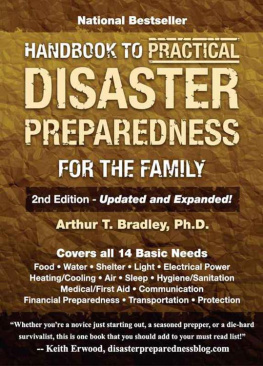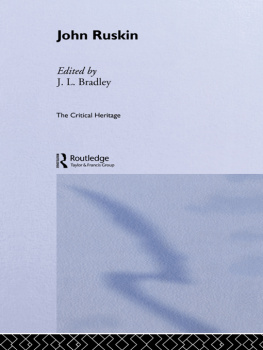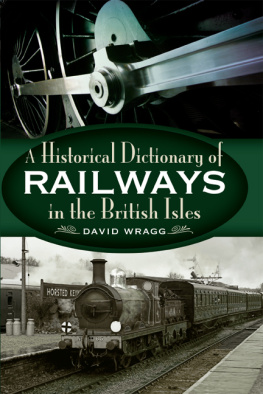THE
RAILWAYS
SIMON BRADLEY is joint editor of the celebrated Pevsner Architectural Guides, to which he has contributed a number of notable revised volumes. He started trainspotting aged eleven, and his interest in railways has broadened and endured. He is the author of St Pancras Station (Profile), and lives in London.
ALSO BY SIMON BRADLEY
St Pancras Station
THE
RAILWAYS
NATION, NETWORK AND PEOPLE
SIMON BRADLEY

First published in Great Britain in 2015 by
PROFILE BOOKS LTD
3 Holford Yard
Bevin Way
London WC1X 9HD
www.profilebooks.com
Copyright Simon Bradley, 2015
The moral right of the author has been asserted.
All rights reserved. Without limiting the rights under copyright reserved above, no part of this publication may be reproduced, stored or introduced into a retrieval system, or transmitted, in any form or by any means (electronic, mechanical, photocopying, recording or otherwise), without the prior written permission of both the copyright owner and the publisher of this book.
A CIP catalogue record for this book is available from the British Library.
eISBN 978 1 84765 352 9
In memory of Peter Carson
INTRODUCTION
U ntil the age of eleven, I paid almost no attention to railways. The family went everywhere by car. Journeys to school were by bus, or on foot (this was the 1970s). What knowledge I had picked up came mostly from the few pages about trains trains rather than railways, that is that cropped up in books of the Our Amazing World kind. These introduced George and Robert Stephenson and their Rocket and proclaimed the Mallards world speed record for a steam locomotive in 1938 as another source of legitimate British pride; but this was tame stuff by comparison with atom-smashers, moon shots or Concorde. My great-grandfather had been an engine driver, and his son had briefly followed him on to the footplate, but it was Grandpas subsequent share in the defeat of the Axis powers that had value in the playground economy of competitive boasting. My fathers wistful cries when old footage of steam locomotives appeared on the television woke no echoes within me. I did not even own a Hornby model railway.
All this changed with secondary school. Mine stood on the triangle of land between the tracks leading away from Clapham Junction. Electric commuter trains passed on one side or another every few seconds, and many boys used them to get to school. This profusion had helped to keep the mid-century trainspotting cult alive for successive cohorts of incoming eleven-year-olds. Most gave up after a year or so, but others stayed keen. We could even register as spotters with the school authorities, a bit like more serious cases of addiction in the world outside. Registered spotters were entitled to spend the lunch hour at otherwise out-of-bounds vantage points, including an iron fire escape with a panorama of the main line to Brighton. Here we were safe from harassment by the schools hard lads and free from nosy invigilation by prefects and masters.
All the locomotives and passenger trains that passed had yellow ends for easy visibility and blue or blue-and-white sides: the corporate colours of our own nationalised British Rail, unchanged since the mid 1960s, the same from Penzance to Thurso. Highlights of the passing show were the diesel-hauled freights, especially those with mixed processions of wagons of every shape and size, sometimes with cargoes exposed: National Coal Board fuels, drums of British Steel Corporation wire, British Leyland cars. Their locomotives might come from depots hundreds of miles away, sometimes in obscure localities familiar only to insiders, such as Toton, Bescot or Healey Mills; places more resonant than suburban Wimbledon or Selhurst, where the commuters electric units were berthed overnight. Trains coasting down the slow incline towards Clapham Junction could be seen half a mile off, prompting competitive displays of recognition skills as the distant yellow blob gradually resolved itself into a distinctive configuration. Trains coming the other way were heard before they were seen, so we tried to memorise the various engine sounds.
We might even wave at the driver in his cab, in the half-ironical spirit with which adolescents carry on with things they fear may appear childish; but we valued the brief transmission of respect when a hand was raised in return. Less exalted in our eyes were the gangs of workers who came regularly to inspect and maintain the four lines of track, retreating to safety every few minutes at a signal from the lookout man; always just too far away for their voices to be overheard, or for their faces to be distinguishable. Driver and ganger alike belonged nonetheless to the world of proper work, visible and practical and comprehensible a world away from the office-bound lives of most of our own fathers. For all that we dodged the odd fare and cheeked the ticket collectors, we sensed the integrity and purpose of the railway. Encouraged by vague ideas of expressing solidarity with the real, there was even a schoolboy fashion for versions of the black donkey jackets worn by the men on the track, the standard working mans apparel of the seventies.
A few summers later, aged sixteen, I spent an entire August day on the end of Platform 4 at Newcastle Central station. The family had returned north to the city of my birth the year before. My new friends there were all mystified by the practice of spotting, and certainly it was hard not to feel self-conscious; surely I was too old for all this now? Dressed in a baggy black V-neck and black corduroys an almost convincing attempt at post-punk style I snootily noted the incongruity with the chosen-by-Mum leisure jackets of other teenage spotters. Yet if anyone had challenged us, we would probably have closed ranks and denied being mere trainspotters; we were interested in railways, we were enthusiasts.
Besides, there were extenuating circumstances: I was trying to give up. At least, I had decided that this should be the last trainspotting day. There was a target in view, too. In a few months, the most powerful express diesel locomotives on the system the Deltics, British Rails Class 55 were due to be withdrawn after twenty years service. These were as charismatic as locomotives could get without actually being powered by steam. At once huge and smartly styled, each was equipped with two marine-type engines and made an intense sound quite unlike anything else on the rails. All twenty-two bore names: some of Derby winners, others of Northern or Scottish regiments. With London school friends, I had clambered exultantly into their unattended cabs on weekend visits to the maintenance depot at Finsbury Park in north London, where the indulgent foreman allowed spotters the run of the place, or begged a few moments on board from their drivers on the platform at Kings Cross. I had since seen all the Deltics but one: 55 021, Argyll & Sutherland Highlander.
That this elusive machine should pull into the station half an hour before I was due to head home, taking the most cinematic approach across the Tyne Bridge and round the sharply curved viaduct towards the platforms, was almost too good to be true. There were even a couple of exposures left on the Kodak to capture the moment. Who cared about looking nerdy now that I had the set? The Deltic numbers printed in my Locoshed Book could become a solid block at last, zebra-striped by evenly spaced underlining. Future sightings would produce a sense of conquest and completion.
A year or so later Argyll & Sutherland Highlander was so many acetylene- cut chunks ready for the furnace and I was no longer spending days on platforms with notebook in hand. Yet the interest in railways endured, growing broader and deeper. Every public library then had a shelf-load of books by post-war authors such as C. Hamilton Ellis, L. T. C. Rolt and David St John Thomas, lively and engaging writers who leavened technical description with human interest and historical understanding. They described the railways of their own time, those of their youth and those of bygone generations. I read my way through these shelves.
Next page


















